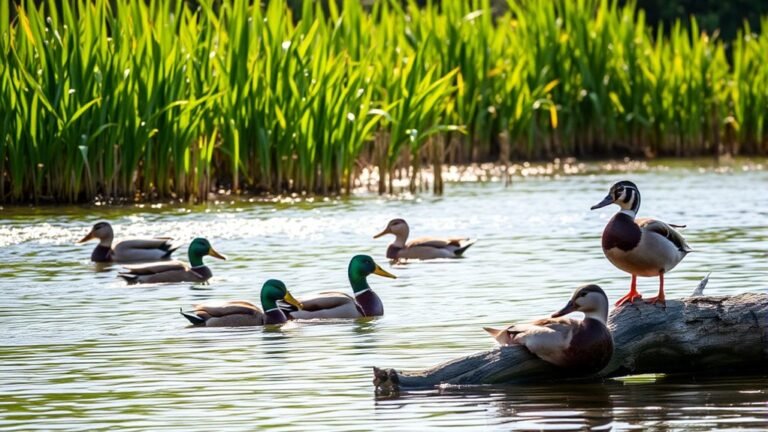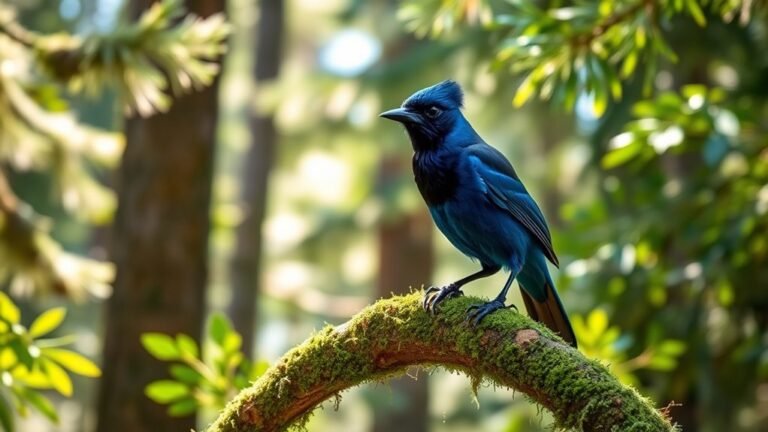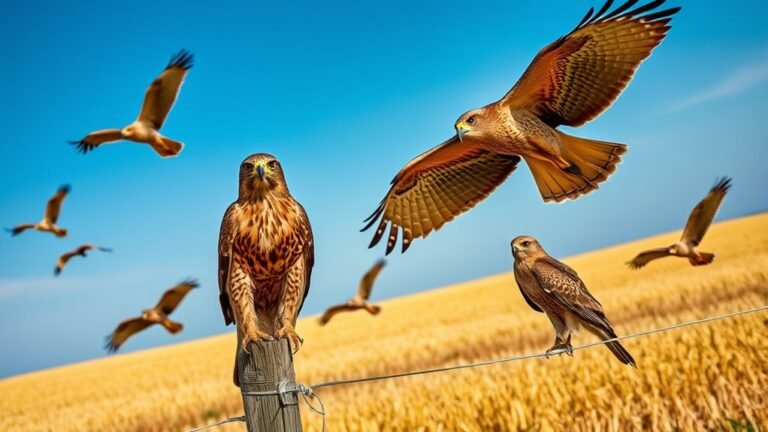Owls Found in Wisconsin: A Birdwatcher’s Guide
Observing owls in Wisconsin can be a fun and exciting adventure for birdwatchers. Each type of owl behaves in its own special way and likes certain places to live. Knowing these details can help you find them in nature.
For example, the Great Horned Owl is big and powerful, while the Barn Owl is shy and likes to hide. Learning where these owls prefer to stay and when they are out and about can make you a better owl watcher. Pay attention to their favorite habitats and times of activity to spot these amazing birds. Enjoy your owl watching!
A Quick Overview
Wisconsin has many owl species, like the Great Horned Owl, Eastern Screech Owl, Barred Owl, and Barn Owl. Each one is unique with different looks and habits.
The best time to watch owls is at dusk. They are most active then, making it easier to see them. Using good binoculars can help you spot and identify the different types of owls.
When you are owl watching, it is important to stay quiet and keep your distance. This way, you won't bother the owls or their homes.
Owls need safe places to live, such as mixed woodlands and wetlands. Protecting these habitats is important for their survival. It also helps us appreciate all the wildlife around us. Happy owling!
Overview of Owls in Wisconsin

Owls are amazing birds that live in many different places in Wisconsin. They're an important part of nature and help keep local ecosystems balanced. There are many types of owls, and they've different ways of moving around as the seasons change. Some owls travel to find food or better places to live.
Owls are mostly active at night. They've special eyes that help them see in the dark and wings that let them fly silently. This makes it easier for them to hunt their prey without being noticed.
Learning about owls can help you understand how important they're to our environment.
Taking care of owl habitats matters. When people work together to protect these spaces, they create a stronger connection with nature and support wildlife.
It's fun to watch and learn about these fascinating birds!
Great Horned Owl
The Great Horned Owl is an amazing bird found in Wisconsin's forests and open spaces. It's strong and very easy to recognize due to its size and the tufts on its head.
Knowing more about how it acts and its sounds can make your birdwatching more fun. Here are some important things to know:
- Behavior: Great Horned Owls are stealthy hunters. They like to catch small animals and birds for food.
- Territorial Nature: Male owls protect their home area very well. They'll chase away other owls that come too close.
- Vocalizations: They make deep hooting sounds. These sounds help them tell others to stay away and attract mates.
- Adaptability: Great Horned Owls can live in many different places, from cities to wild forests.
Watching these beautiful owls can help you feel closer to nature.
You'll also learn how they fit into the environment.
Enjoy birdwatching!
Eastern Screech Owl

The Eastern Screech Owl is a small and charming bird. It stands about 6 to 10 inches tall. This owl comes in two main colors: gray and reddish-brown. Its feathers blend well with trees, helping it hide from view.
At dusk, you can hear the Eastern Screech Owl making its unique calls. It sounds like a series of soft trills and whinnies. These sounds help the owls talk to each other and mark their territory.
One fun feature of the Eastern Screech Owl is its feathered ear tufts. These tufts make the owl look even more expressive and interesting.
If you watch this owl, you'll see how special it's and enjoy its many unique traits.
Barred Owl
Barred Owls are big and beautiful birds. You can tell them apart by their brown-and-white striped feathers.
Let's look at some interesting things about them:
- Sound: Barred Owls make a famous call that sounds like "who cooks for you?" You can hear this sound echoing in the woods at night.
- Eating Habits: They mainly eat small animals like mice and birds. Sometimes, they also eat reptiles. This shows how they can find food in different ways.
- Nighttime Life: These owls are mostly awake at night. They've sharp hearing and good eyesight, which helps them catch their food.
- Protecting Their Homes: Barred Owls take care of their nests. They're protective and will often make loud sounds or fight off other birds that come too close.
Learning about how Barred Owls live and what they eat can really make your birdwatching trips in Wisconsin fun and exciting!
Barn Owl

The Barn Owl is a cool bird to see in Wisconsin. It has a unique heart-shaped face and light, speckled feathers. These owls like open spaces like farms and fields, and sometimes they even live in old buildings. This makes them easy to find for people who love to watch birds.
Barn Owls are active at night. They hunt mainly for small animals like mice. They can hear really well, which helps them find their food in bushes and tall grass. Watching them fly silently can be really amazing. Their feathers are special and help them move quietly.
During the time they've babies, you might find them resting in tree holes or old structures. They usually stay with one partner.
Learning about Barn Owls and their important role in nature can help you appreciate Wisconsin's wildlife even more.
Long-eared Owl
In Wisconsin, the Long-eared Owl is an interesting bird to learn about. These owls like to live in open forests and thick bushes. Their unique habitat makes them stand out.
You can easily spot a Long-eared Owl because of its long tufts of feathers that look like ears and its bright orange eyes. They're most active during dusk when they hunt for food. During this time, you might hear their gentle calls, especially in mating season.
Long-eared Owls mainly eat small mammals, which shows how good they're at hunting. Watching these owls in the wild is a fun experience and helps you appreciate the variety of animals in Wisconsin.
Short-eared Owl
The Short-eared Owl is a cool bird that lives in the open fields and marshes of Wisconsin. This owl is very good at adapting to its surroundings. During the breeding season, it makes nests in the tall grasses. If you look for them, you'll often see them hunting at dusk. Their shape stands out against the evening sky, which is a beautiful sight.
These owls rely on grassy areas to find food and nest. This makes it important to take care of these habitats. By protecting these spaces, we help ensure they've enough food, which helps their numbers grow.
If you visit these fields and marshes, think about helping local conservation projects. You can meet other birdwatchers who also want to protect these birds and their homes.
Together, you can enjoy watching these amazing owls as they fly gracefully through the twilight sky.
Northern Saw-whet Owl
Northern Saw-whet Owls are a bit trickier to find than Short-eared Owls. They stay in thick coniferous forests in Wisconsin during winter. These small owls are fascinating to watch, especially at night.
Here are some easy tips to help you spot them:
- Go to urban woods or parks with lots of conifer trees.
- Listen for their unique tooting sound on quiet nights.
- Look up in the trees; they often hide well because they look like bark.
- Use a flashlight with a red filter so you don't disturb them too much.
Joining the owl-watching community can make your experience even better. You'll meet other people who love these amazing birds just like you do!
Burrowing Owl
Burrowing Owls are special birds found in Wisconsin. Unlike other owls, they make their homes in underground burrows instead of trees. You can see them in places like open grasslands and farm fields. They often use burrows made by animals like prairie dogs.
These owls dig into the ground to stay safe from predators and to keep their eggs at a comfortable temperature. They also have a fun and social side, often interacting with other owls nearby.
It's important to protect their homes because losing these spaces can put these owls at risk.
If you pay attention, you might catch a glimpse of them peeking out of their burrows. Burrowing Owls help control pests in their environment, making them an essential part of the ecosystem.
Spotted Owl
The Spotted Owl is a special kind of owl that lives in Wisconsin. It needs certain places to survive and thrive. Here are some important things to know about this unique bird.
- Home Sweet Home: Spotted Owls like to live in old forests. These forests have tall trees and thick leaves, which help them stay safe and find mates.
- What They Eat: Spotted Owls mainly eat small animals like mice and insects. They need plenty of these animals around to stay healthy.
- Hoots and Calls: You can hear Spotted Owls at night. They make a special hooting sound that helps birdwatchers find them.
- Saving the Spotted Owl: This owl is in trouble and needs our help. It's considered threatened because of habitat loss.
Protecting their homes is very important for their survival.
Habitat Preferences of Wisconsin Owls
Wisconsin owls have special places where they like to live. These birds enjoy mixed woodlands, wetlands, and open fields. Big trees are really important for them because they give shelter and high places to look for food.
Different owls have different hunting styles. For example, the Great Horned Owl likes to hide in thick forests so it can sneak up on its dinner.
On the other hand, the Barred Owl loves wet areas. It uses its sharp hearing to find its next meal there.
If you pay attention to where these owls like to stay, you can have more fun watching them. You might even help protect their homes! Learning about these wonderful birds helps you connect with Wisconsin's amazing wildlife.
Best Practices for Owl Watching in Wisconsin
How can you have the best owl watching experience in Wisconsin? Following some simple tips will help you enjoy yourself while keeping the owls safe. Here are four easy ways to make your owl watching fun:
- Visit at the Right Time: Go to places where owls live during dusk. That's when they're most active, and you can see them better.
- Use Good Gear: Get a nice pair of binoculars and a field guide about Wisconsin owls. This will help you spot and identify them easily.
- Stay Back: Keep a good distance from the owls. This way, you won't scare them or disrupt what they're doing. Let them act naturally.
- Be Quiet: Keep noise to a minimum. Try to move slowly and quietly. This will help you enjoy watching the owls without bothering them.
By following these tips, you can have a great time owl watching while also being kind to these beautiful birds.
Happy watching!
Frequently Asked Questions
What Time of Year Are Owls Most Active in Wisconsin?
Owls are most active in the winter. This is when they start their breeding season. During these cold months, you can watch their interesting behaviors as they look for mates and set up their homes. It's a great time to learn about how they find partners and defend their territories.
How Can I Attract Owls to My Backyard?
To attract owls to your backyard, you can set up owl feeders and plant native plants. These steps help create a nice place for owls to live. Adding perches for them to sit on can also make your yard more inviting. When you make your backyard comfortable and appealing, you have a better chance of seeing these amazing birds. Enjoy the beauty of nature by inviting owls into your space!
Are Any Owls in Wisconsin Endangered or Threatened?
Yes, some owls in Wisconsin are in danger. These owls need special care to help them survive. People are working hard to protect their homes and the places where they live. By learning about these owls and supporting these efforts, you can help them stay safe and thrive. Every little bit counts!
What Sounds Do Wisconsin Owls Make?
Wisconsin has many types of owls, and each one makes different sounds. When you listen to them, you can hear their unique calls. For instance, the Great Horned Owl makes a loud, haunting hoot. It sounds almost spooky! On the other hand, the Eastern Screech Owl makes soft, repetitive calls. Each owl uses its sounds for different reasons. So, next time you're outside at night, pay attention to the owls. You might hear some interesting calls!
Can Owls Be Seen During the Day?
Yes, you can see owls during the day. Even though they mostly come out at night, sometimes they are active when the sun is up. You might spot them hunting or resting. Catching a glimpse of an owl during the day can help you learn more about how they live and where they find food. Observing these beautiful birds can be an exciting experience!

Luna is the passionate founder and author of Birds and You, a website dedicated to sharing her love for birds with fellow enthusiasts. Through her engaging articles and guides, she aims to educate and inspire others to explore the fascinating world of birds. When she’s not writing, you can find Luna observing birds in their natural habitats or sharing beautiful bird photography on Pinterest. Join her on this journey to celebrate and protect our feathered friends!







